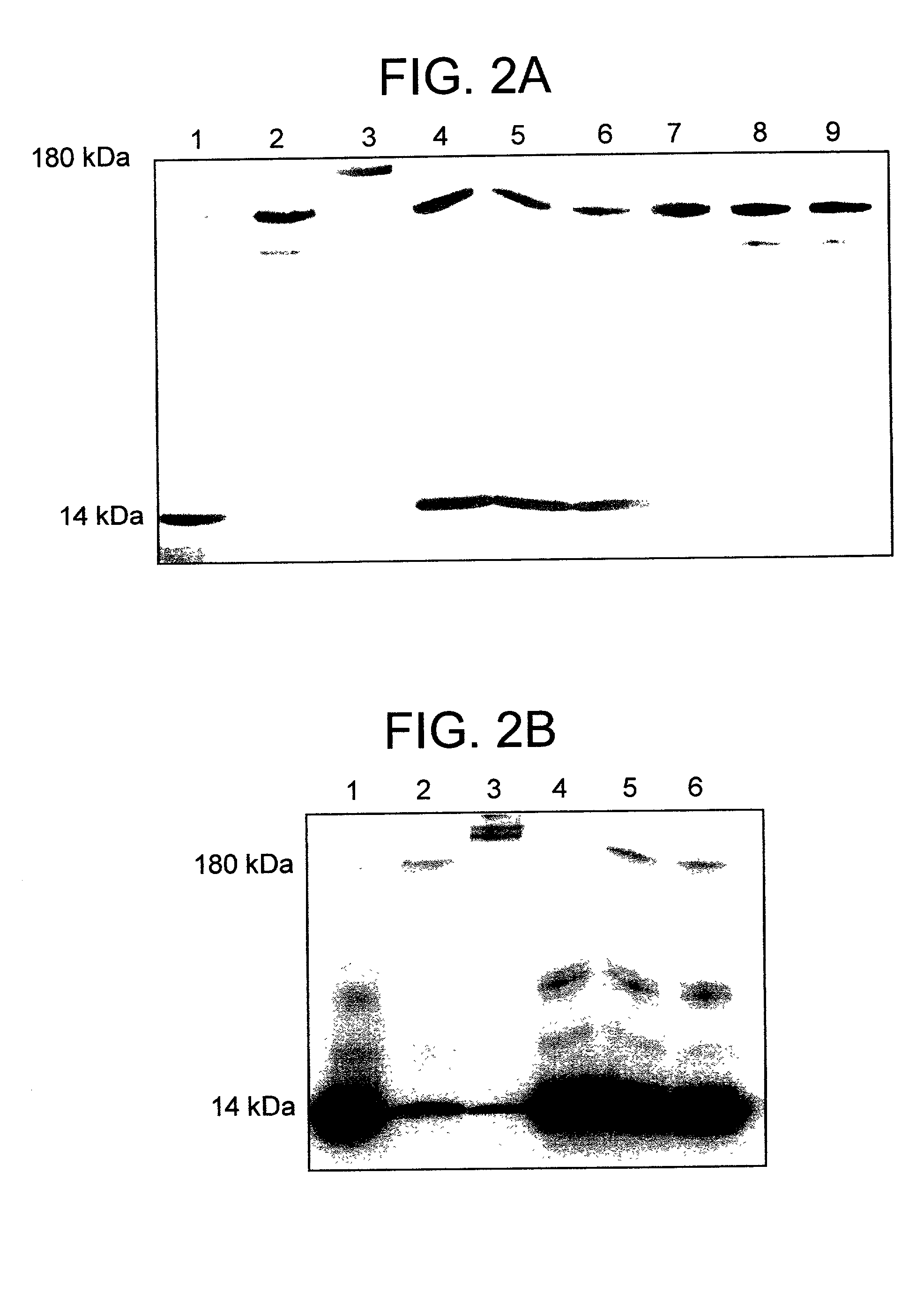Immune response modulator alpha-2 macroglobulin complex
a macroglobulin complex and immune response technology, applied in the field of immunology, can solve the problems of inability to raise antibodies against such epitopes, inability to induce cytotoxic t lymphocytes (ctl) response in vivo, toxic and unacceptable to humans, popular adjuvants used in laboratory animals, such as freund's complete adjuvants, etc., to achieve enhanced antigenicity, effective antigen presentation, and effective stimulation of immune response
- Summary
- Abstract
- Description
- Claims
- Application Information
AI Technical Summary
Benefits of technology
Problems solved by technology
Method used
Image
Examples
example 1
[0116] .alpha..sub.2-Macroglobulin* was prepared as described above and incubated with a forty-fold molar excess of .sup.125I-Bolton-Hunter-label- ed hen egg lysozyme at 50.degree. C. The samples were analyzed by non-denaturing pore-limit PAGE (FIG. 1A). The control samples, in the absence of lysozyme, behaved as expected (18), reverting to the "slow" migrating conformation characteristic of native .alpha..sub.2M (FIG. 1A, lanes 6-8). However, in the presence of lysozyme there was a distribution of "slow" and "fast" migrating .alpha..sub.2M even after 24 h at 50.degree. C. (FIG. 1A, lane 5). The gels were dried and scanned for radioactivity on a PHOSPHORIMAGER (FIG. 1B). Radioactivity was identified only in the samples that had been incubated with .sup.125I-lysozyme, and it migrated at the position corresponding to "fast", receptor-recognized .alpha..sub.2M* (FIG. 1B, lanes 3-5). To further confirm the position of the radioactive band, an aliquot of the complex isolated after 5 h of...
example 2
[0117] To further characterize the complex, .alpha..sub.2M* was incubated with a forty-fold excess of .sup.125I-Bolton-Hunter labeled lysozyme at 50.degree. C. (5 h) as described above. The complex formed was separated from the free ligand by gel filtration on an S-300-HR column. As expected, both "fast" and "slow" migrating .alpha..sub.2M was present when analyzed by non-denaturing pore-limit PAGE (FIG. 1A, lane 9). It is not possible to separate the two forms of the macroglobulin by gel filtration and the stoichiometry presented is based on the mixture of the two forms. The amount of lysozyme incorporated was determined from the total protein concentration (A.sub.280nm), the radioactivity incorporated, and the specific radioactivity of the .sup.125I-Bolton-Hunter labeled lysozyme (3000-5000 c.p.m. / pmol). The complex had approximately 2.3 moles of lysozyme bound to each mole of .alpha..sub.2M (see Table 1 below). More than 94% of the radioactivity of the complex was precipitated wi...
example 3
[0118] The efficiency of the reaction at lower temperatures was investigated. .alpha..sub.2M* was incubated with a forty-fold excess of .sup.125I-lysozyme at 23.degree. C. and 37.degree. C. and a time course study was performed. Even after 24 h of incubation at 23.degree. C., there was no covalent incorporation of lysozyme into .alpha..sub.2M*, as analyzed by SDS-PAGE and centrifugal microfiltration of the SDS treated, isolated complex. As was observed at 50.degree. C., at 37.degree. C. the time-dependent electrophoretic mobility pattern of .alpha..sub.2M* changed in the presence of lysozyme and less of the macroglobulin reverted to the "slow" migrating conformation characteristic of native a .alpha..sub.2M (FIG. 3A, lanes 3 and 6). SDS-PAGE determined the optimal time for covalent incorporation to 24 h. The complex which was isolated after 24 h at 37.degree. C. had approximately 6.6 moles of lysozyme bound to each mole of .alpha..sub.2M (see Table 1 above). The level of non-covalen...
PUM
| Property | Measurement | Unit |
|---|---|---|
| molecular weight | aaaaa | aaaaa |
| temperature | aaaaa | aaaaa |
| temperature | aaaaa | aaaaa |
Abstract
Description
Claims
Application Information
 Login to View More
Login to View More - R&D
- Intellectual Property
- Life Sciences
- Materials
- Tech Scout
- Unparalleled Data Quality
- Higher Quality Content
- 60% Fewer Hallucinations
Browse by: Latest US Patents, China's latest patents, Technical Efficacy Thesaurus, Application Domain, Technology Topic, Popular Technical Reports.
© 2025 PatSnap. All rights reserved.Legal|Privacy policy|Modern Slavery Act Transparency Statement|Sitemap|About US| Contact US: help@patsnap.com



